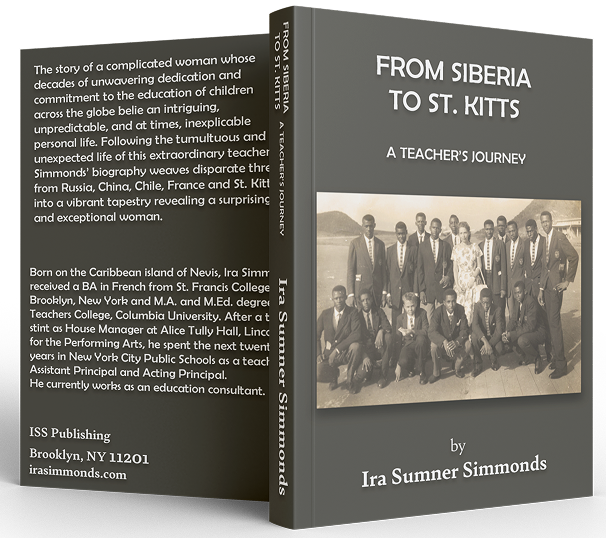Education is often discussed in terms of systems, standards, or policies, but the most meaningful impact comes from the individuals who teach. From Siberia to St. Kitts, written by Ira Sumner Simmonds, tells the story of Madame Zenaida Katzen—a teacher whose life and work reflected a rare blend of discipline, global understanding, and personal dedication. Among the many books about global education, this one stands out not for its theories but for its honesty, cultural range, and timeless educational values.
A Teacher’s Story Told Through Global Context
Madame Katzen’s life cannot be confined to one location or culture. She was born in Siberia, educated in Europe and Asia, and eventually settled in the Caribbean, where she spent decades teaching French and Spanish. Her life was shaped by migration, political unrest, and cross-cultural learning. This rich context shaped her teaching and her worldview.
Many books about global education focus on institutional models or comparative systems. In contrast, From Siberia to St. Kitts brings global education down to a personal level. It presents a single educator who carried her multilingual, multicultural experiences into the classroom and helped students think beyond the island they lived on.
Teaching Through Structure and Expectation
Madame Katzen was known for her disciplined approach to teaching. Her classes were rigorous, immersive, and structured. She spoke only the language she was teaching and expected her students to adapt quickly. Her methods may have seemed strict, but they built confidence and independence in her students.
This kind of immersive teaching is often referenced in educational theory but rarely shown in practice through real accounts. That’s what makes this biography special. It doesn’t just explain what effective teaching looks like—it shows it in action. In the world of books about global education, that kind of practical example is invaluable for educators and learners alike.
Real Impact Over Time
The author, Ira Simmonds, writes not as an outsider or academic observer but as a former student. His decision to write about Madame Katzen came from his own reflection on how her teaching shaped his personal and professional life. He later became an educator himself, and her lessons stayed with him for decades.
Throughout the book, other students also share their stories. Many went on to successful careers and credit Madame Katzen for instilling in them the discipline, perspective, and confidence they needed to succeed. These accounts give the book emotional depth and long-term relevance.
While many books about global education rely on short-term results or program outcomes, From Siberia to St. Kitts provides lasting examples of how great teachers leave an impact that stretches far beyond the classroom.
Cultural Awareness as Educational Foundation
In today’s world, cultural awareness is an essential part of education. Madame Katzen’s classroom was an early model of this concept. She taught languages as a way of connecting with the world. Her lessons included music, conversation, food, and social interaction. Language, for her, wasn’t just vocabulary—it was a doorway to cultural understanding.
She hosted students in her home, encouraging them to speak only the target language in a supportive environment. This helped students develop fluency and cultural comfort in ways that textbooks alone could never provide.
Within the space of books about global education, this kind of hands-on, culturally rich teaching method deserves more attention. It reminds educators that real-world engagement, even in modest settings, can have powerful outcomes.
A Personal Story with Universal Relevance
Though Madame Katzen’s life was specific, her story carries meaning far beyond one person. It represents what happens when a teacher cares deeply, expects the best, and treats education as a lifelong mission. Her classrooms weren’t built on innovation or technology. They were grounded in effort, preparation, and respect.
The book shows that real change doesn’t require a new curriculum or massive reform—it often begins with one person doing their job with excellence and consistency. In contrast to other books about global education that focus on institutions or policies, this one shows the difference made by one individual’s daily choices.
Why This Book Matters Now
In times of educational disruption and rapid change, there is growing interest in models that work on a human level. From Siberia to St. Kitts is timely because it brings attention back to core principles: discipline, language learning, cultural respect, and mentorship.
Its relevance goes beyond the Caribbean. Teachers and students anywhere can relate to its messages. The book also brings attention to voices often missing in global education discourse—immigrant women, small-island educators, and multilingual teachers without formal accolades but undeniable influence.
Few books about global education include this perspective, and even fewer present it with such sincerity and clarity.
Closing Remarks
From Siberia to St. Kitts is a teaching resource, a cultural reflection, and a reminder of what matters in education. Madame Zenaida Katzen’s life, seen through the eyes of a former student, shows how true teaching happens over time, with purpose, and through personal example.
In the wider world of books about global education, this book stands out for its simplicity, depth, and emotional truth. It doesn’t argue—it shows. It doesn’t generalize—it remembers. And in doing so, it helps readers understand that great teaching is universal, no matter where it happens.
Read From Siberia to St. Kitts and see how one teacher’s influence crossed languages, countries, and generations.
It’s one of the most meaningful stories you’ll find about global education.

